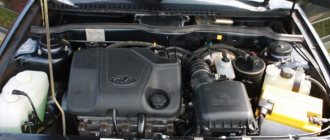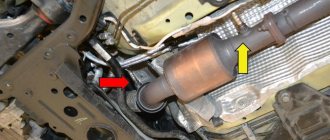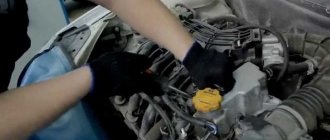Many car enthusiasts and owners of a VAZ 2110 with an eight-valve engine encountered the fact that the engine began to trip. Of course, the majority immediately went to a car service center, where after short and simple operations everything returned to normal. In this article, we will look at the main reasons why the problem occurs and ways to solve it at home.
Causes of malfunction
The VAZ 2110 8 valve engine is not complex in its design features, and therefore it is quite easy to establish the reasons. But, beginners cannot cope with the task and are forced to contact a car service, which is not always necessary. In fact, the VAZ 2110 engine has 8 valves for several reasons. Let's look at where to look for reasons:
- Malfunctions of the injection system.
- Failure in the ignition system.
- Sensors and ECU.
- Throttle.
- Air filter element.
- Piston group.
When is it time to check the engine?
The engine should always run like a clock, that is, smoothly and without jerking, dips, or jumps. At idle speed it is easy to notice that the engine is unstable. When such suspicions creep in, it is better to raise the hood and listen to the beats in all cylinders. “Troit” means one or two cylinders are inactive, since there are no conditions necessary to ensure the processes in their combustion chambers. As a result, the actual power of the power unit drops noticeably and gasoline consumption increases. There is also a tendency to stall, for example at intersections, at traffic lights or during warm-up. At the same time, when the engine of a VAZ 2110 fails, the reasons for such a malfunction can be different.
You can find out which cylinder has problems in one simple and long-known way. With the engine running, you need to remove the high-voltage wire from each spark plug one by one. If the cylinder was working properly before, then when it is turned off there will be a noticeable dip and a drop in speed (look at the tachometer scale). If there are no changes after removing the wire from the spark plug, we can safely assume that the problem is precisely in this cylinder - it was not working before the shutdown.
Solution methods
Now that the main causes have been identified, you can proceed directly to troubleshooting methods . Before we begin, it is worth noting that not all faults can be identified independently, much less eliminated. Let's look at what needs to be done to eliminate engine tripping.
Fuel rail and injectors
The most common cause of engine tripping is a malfunction of the injectors and fuel rail. To eliminate the cause, it is necessary to disassemble this element. The fuel rail is inspected for cracks and deformations. But with candles, not everything is as simple as it seems at first glance.
To determine the performance of the elements, they need to be run through a special stand, which will show whether the injector will work. If they become clogged, they must be cleaned at a nozzle cleaning stand, and if the element is completely faulty, then replace it with a new one.
Spark plugs and wires
Another reason why the power unit fails is the spark plugs and high-voltage wires. So, it is worth removing the elements from the engine and conducting diagnostics. Spark plugs, first of all, are inspected for integrity, and then checked on a special spark plug stand. If everything is in order with the spark plugs, then it is necessary to set the contact gap before installation.
High-voltage wires are checked with a conventional resistance tester. So, a good quality wire will have a resistance of 5 ohms. Deviation from this indicator is considered to indicate that the wires are not suitable for further use and must be replaced with new ones.
Sensors
Failure of several sensors can lead to the motor becoming unstable and tripping. This could be a failure of the TPS, IAC, camshaft sensor, or DMVR. When all these components fail, they signal the electronic engine control unit, which in turn outputs information to the driver. The malfunction can be eliminated by replacing the corresponding sensor.
There are two ways to determine the performance of the sensor - measuring each sensor one by one with a tester, or connecting to the on-board computer, where an error will pop up, decoding which you can determine the location of the problem.
Throttle valve
A faulty throttle valve can cause the engine to shake. To cure the malfunction, you need to dismantle the element and clean it. Today, there are a sufficient number of products on the auto chemical market that can be used to clean this unit.
But the most popular folk method remains carburetor cleaner, or VD-40. Both products clean out accumulated dirt and dust quite well.
Air filter
The air filter remains a known problem with engine tripping. Thus, untimely replacement of this element can lead to insufficient or incorrect formation of the air-fuel mixture. This is due to the fact that a dirty filter leads to poor air permeability and the engine simply begins to choke.
To eliminate the problem, it will be enough to replace the air filter element. Since the VAZ engine has simple design features, any motorist can cope with this task without much difficulty. So, to replace the air filter you need to get into the engine compartment. Then, unscrew the four bolts securing the air filter cover and change the filter element.
Piston rings and pistons
Another factor why the VAZ 2110 engine troits the 8-valve injector is due to the reasons in the piston mechanism. This especially applies to cars that have traveled a significant mileage. Thus, deformation of the piston rings can lead not only to tripping of the power unit, but also to increased consumption of fuel and lubricating elements.
Of course, you should understand that if these rings are the culprit for unstable engine operation, then a major overhaul is approaching, so there is no need to delay troubleshooting.
The second option for the effect to occur is burnout of the piston mechanism, or rather the pistons and valves. So, the oil gets into the cylinders and begins to burn out. As for the valves, a gap appears between the chamfer and the seat, through which exhaust gases begin to flow into the cylinders, which leads to the effect of a suffocating power unit.
Fixing the problem is quite simple - replace the elements with new ones. As practice shows, this type of repair does not help for long, and sooner or later you have to resort to a major overhaul of the engine.
ECU
The last element of the engine that could lead to tripping is the electronic engine control unit. Thus, the elementary accumulation of errors inside the on-board computer causes the operation of the main systems and sensors to malfunction.
To solve the problem, you will have to connect to the computer using a special cable and reset the accumulated errors. If this option does not help, you will have to flash the on-board computer. In this case, it is recommended to turn to professionals, since one careless movement and the control unit may no longer start at all.
VAZ 2110 injector takes a long time to start - 8 and 16 valves, what to do if the problem is cold
Hi all! There is a VAZ 2111. Engine 21114 - 8 cells, 1.6. Bosch 797. It always takes a long time to start - both cold and hot. Problem since summer. The remote control was washed. Everything is clean and not clogged. The valves have been adjusted. Cleaned the injectors. I checked the suction pipes and replaced many. The air filter is new. The fuel tank strainer has been replaced. The rail pressure is around 3.8. The check engine light is constantly on. The BC displays a mass loss error (1602). But it’s unlikely that the check is related to this mass error, because she's been around for a long time. There are no problems when driving (I don’t drive). True, there is one nuance - sometimes when accelerating/driving around 2000 rpm there is a certain gag - the car seems to twitch/gouge for a second and then drives normally. The voltage at the mass air flow sensor is 1.04. But there are no floating edges or a noticeable drop in traction. The muffler-resonator connection cuts. But this happened before. I'm tired of twisting new clamps. Scored. But this is true, just in case it can help with the diagnosis) Here are the readings from the BC in three modes - immediately after start (23g), warmed up (88g) - XX and 3000 rpm.
Temperature 23 g Speed 1240 Consumption l/h 2.21 VAF 1.72 v Reg. XX steps 94 DC 0.45 in UOZ 3.7 Air consumption kg/h 23.9
Temperature 88 g Speed 800-840 Consumption l/h 1 VAF 1.5 v Reg. XX steps 36 DC 0.66 in UOZ 9.7 Air consumption kg/h 11.1
Temperature 88 g Speed 3000 Consumption l/h 3.55 VAF 1.92 v Reg. XX steps 80 DC 0.11 V Throttle 4% UOZ 30.7 Air consumption kg/h 34.1
Conclusion
The main reasons for the VAZ 2110 8-valve engine tripping are identified, and methods for solving the problem are described. So, the main problems arise due to an incorrect air-fuel mixture, the formation of a spark or in the piston mechanism. There are different ways to solve the problem.
But, it is recommended to turn to professionals in solving such problems who can do everything quickly and efficiently. Because improper repairs can lead to even bigger problems, which will entail additional costs.
Problems with the injection system
There are some specific problems with the injection system that can cause tripping or similar problems with the VAZ 2110 engine:
- malfunction of the idle speed controller;
- clogging of injector nozzles;
- contamination of the fuel pump, fuel or air filter;
- failure of the mass air flow sensor;
- throttle position sensor failure;
- contamination of the engine crankcase ventilation system;
- ECU malfunction.
Crankshaft position sensor (CPS)
Often the engine stalls due to problems with the DPKV. To check, you will have to remove this sensor from the engine. Be sure to mark its position on the engine.
After removal, you need to measure the resistance of the sensor inductive coil. The multimeter should show a resistance between 550 and 750 ohms. Anything more or less indicates a sensor malfunction. It needs to be replaced. There are other testing methods, but they are “difficult to apply” in a regular garage.
Now a short video with another reason.
Ignition
Before checking the entire system, it is necessary to identify the inoperative cylinder. This is done as follows: the high-voltage wires are pulled off the spark plugs one by one.
At the same time, the working cylinders react to this action, the engine begins to wither. If the non-working cylinder is disconnected from the ignition, the engine will not react to this in any way. After determining the inoperative cylinder, unscrew the spark plug. Problems with it or with the ignition system are indicated by the presence of fuel residues on it, the spark plug is “wet”. You can try replacing the spark plug and installing another high voltage. You may find that when you start the engine, it runs fine. If this does not happen, you need to continue checking. The simplest solution is to replace your module with one that is known to work. If this is the problem, then the engine should start working correctly. Also possible. To do this, you need to measure the resistance at the terminals. This needs to be done in pairs. Combine cylinders 1 and 4, as well as cylinders 2 and 3. The resistance should be between 5.2 and 5.5 ohms. The ignition module cannot be repaired; if it malfunctions, it will have to be replaced.
Why is the car shaking?
The most accurate answer is a problem with the power supply or ignition system in the engine. The tripping effect (when one of the cylinders does not work correctly or has failed completely) in 90% of cases is caused by a malfunction in the fuel supply or spark. Typically on VAZ models, the breakdown is associated with a malfunction of the following components:
- Spark plug. The most problematic node. Typically, part failure is caused by poor quality or incompatibility. Buyers unknowingly select items of the wrong type.
- Low quality gasoline - “bad” fuel may contain non-combustible impurities, which causes the internal combustion engine to malfunction.
- Wiring. High-voltage lines, terminals and connectors.
- Failure of MVR sensors or interruptions in the operation of the ECU - defects are typical for injection VAZ cars.
- Problems in the distributor - relevant in carburetor engines.
- Violation of the integrity of the fuel lines.
- Fuel supply interruptions.
- The air supply system is not working correctly.
- Reduced compression of the working cylinders is the most expensive failure.
Note! For carburetor and injection type models, repairs are carried out according to different principles.
Diagnostics
Troubleshooting depends greatly on the type of engine power supply design. Therefore, further consideration will take place individually.
While driving
It is also an unpleasant situation when the car has jerks and dips during acceleration. This can happen both when driving and when starting off. A particularly unpleasant, or even dangerous, situation can arise while driving, for example, when a car is about to overtake, and then there is a sudden failure.
The causes of jerks during acceleration can be both those already mentioned and slightly different ones:
- If you have a carbureted car that jerks when accelerating, this may indicate that the ignition is too early. You need to set the lead angle. And checking the ignition timing is quite simple: at speed 4, accelerate to 50 km/h and brake sharply. If detonation lasts 1-2 seconds, then the ignition is set perfectly, the reason is not there;
- on “injectors” everything is controlled electronically. There, the jerking while driving and during acceleration may be due to the mixture being too lean. But this should be shown by diagnostics in the service. If the sensors “know about this, but are silent,” then it is quite possible that they themselves are faulty and must be replaced.
Nutrition
Often, the cause of engine tripping is the power supply system. First of all, the problem may be caused by low-quality fuel. To check, try changing the fuel. You can also try cleaning the injectors.
Their blockage can also cause tripping. For this purpose, special compounds are used. It is not recommended to pour cleaners into the tank. It is better to make a temporary power supply system; cleaning is carried out according to the instructions indicated on the package. After cleaning the injectors this way, the spark plugs should be replaced with new ones.











